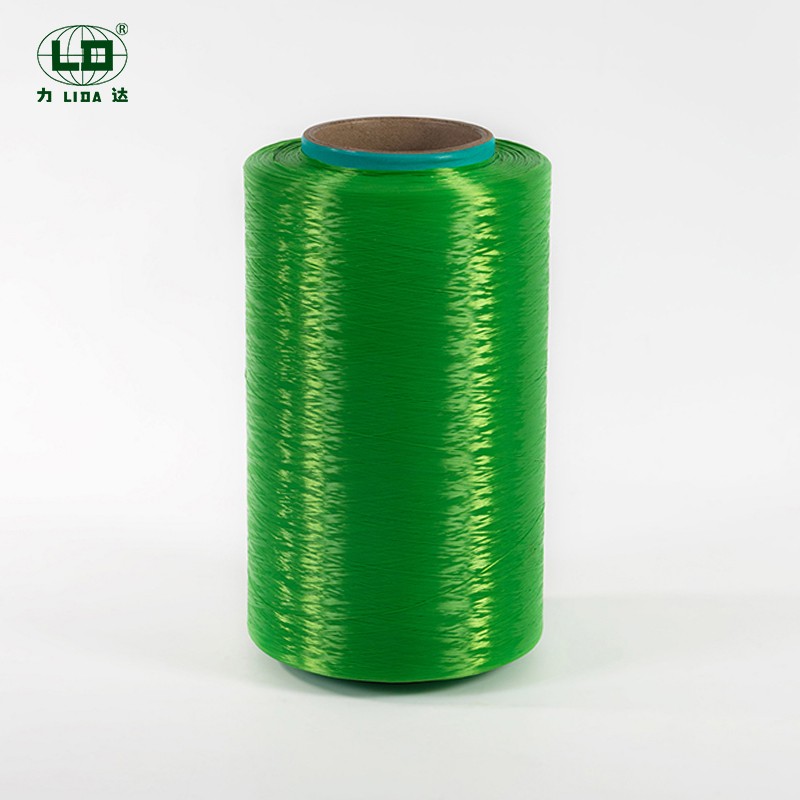

1、 Principle of Core Function Implementation
Anti UV polyester dope dyed filament yarn achieves a protective effect (UPF value ≥ 50+) by introducing UV absorbers (such as benzophenones and benzotriazoles) into the fibers, converting UV rays (UV-A/UV-B) into thermal energy or low-energy radiation. The combination of dyeing and anti UV function needs to balance the stability and compatibility of both.

2、 Detailed explanation of key production processes
(1) Raw material pretreatment and modification
Selection of UV absorbers
Requirements: Particle size ≤ 1 μ m (to avoid spinning blockage), thermal stability ≥ 280 ℃ (high temperature resistance for polymerization), good compatibility with polyester (to prevent precipitation).
Type:
Organic small molecule absorbents (such as UV-531): introduced through blended yarns, with an absorption wavelength of 290-400nm.
Nano inorganic powders (such as TiO ₂, ZnO): with a particle size of 50-100nm, enhance protection by scattering ultraviolet light, and require surface modification (silane coupling agent treatment) to improve dispersibility.
Preparation of Polyester Slices
Blending modification: During the polyester melt polymerization stage (or after solid-state polymerization), UV absorbent masterbatch is added at a ratio of 0.5% -2% and uniformly dispersed through a twin-screw extruder.
Co polymerization modification: monomers containing UV absorbing groups (such as benzotriazole p-hydroxybenzoate) are incorporated into polyester molecular chains to achieve permanent UV resistance (high cost, suitable for high-end products).
(2) Spinning and stretching process
Spinning parameter control
Temperature: Melt spinning temperature is 285-300 ℃ (5-10 ℃ higher than ordinary polyester) to avoid decomposition or agglomeration of the absorbent.
Speed: High speed spinning (4000-5000 m/min) combined with fine denier (15-50 dtex) to increase fiber specific surface area and enhance UV shielding effect.
Stretching and shaping optimization
Stretching ratio: 3.5-4.0 times, improves fiber crystallinity (crystallinity ≥ 45%), reduces amorphous defects, and avoids UV penetration.
Heat setting temperature: 180-200 ℃ (10-20 ℃ lower than ordinary polyester), to prevent thermal decomposition of absorbent and control shrinkage rate ≤ 8%.
(3) Dyeing process (key compatibility control)
Selection of dyeing methods
Raw liquid coloring+UV resistant blending: Before spinning, pigment masterbatch and UV absorber are added simultaneously, suitable for dark products (black, navy blue, etc., the pigment itself can assist in shading), with color fastness ≥ 4 levels and long-lasting UV protection.
Post staining+anti UV finishing:
Disperse dyes should be used for high-temperature and high-pressure dyeing (130 ℃ × 30min), and dyes with good compatibility with absorbents should be selected (such as azo type disperse dyes, to avoid photochemical reactions between anthraquinone type dyes and absorbents).
After dyeing, dip rolling anti ultraviolet finishing agent (such as water-based UV absorbent lotion) is suitable for light color products, but its washing resistance is poor (usually the UPF value decreases by 20% after 5 times of washing).
Optimization of dyeing process
PH control: The pH of the dye bath is 4.5-5.5 (weakly acidic) to prevent the absorbent from decomposing under alkaline conditions (such as benzophenones being easily hydrolyzed at pH>7).
Additive selection: Add non-ionic leveling agents (such as fatty alcohol polyoxyethylene ether) to avoid charge repulsion between ionic additives and absorbents, which can affect dispersibility.
(4) Functional synergy control
The interaction between absorbent and dye
UV absorbers may compete with dyes for binding sites on fibers, leading to a decrease in dyeing depth (K/S value reduced by 10% -15%), which needs to be compensated by increasing dye dosage or optimizing the formula.
For example, when dyeing deep blue, the amount of ordinary polyester dye used is 2% (owf), and the amount of UV resistant polyester needs to be increased to 2.5% -3% (owf).
Improved light fastness
UV absorbers can assist in improving the light fastness of dyes (such as increasing the light resistance level of Disperse Red 60 dye on UV resistant fibers from level 3 to level 4), as absorbers reduce the damage of UV rays to dye molecules.
3、 Technological difficulties and solutions
Poor dispersibility of absorbent
Problem: Agglomeration leads to spinning breakage and decreased fiber strength.
Solution: Adopting nano grinding technology (grinding with a sand mill to D50 ≤ 500nm)+surface modification (such as coating TiO ₂ with stearic acid).
Insufficient uniformity of staining
Problem: Absorbents affect the dyeing rate of dyes, leading to discoloration.
Scheme: Segmented heating and dyeing (such as heating at 1 ℃/min for 30-60 ℃ and 2 ℃/min for 60-130 ℃), extending the insulation time to 40 minutes.
Functional durability
Problem: Poor washing resistance of anti UV agents after finishing.
Solution: Reactive absorbents (such as UV absorbents containing epoxy groups) are used to covalently bond with fibers through cross-linking reactions, with a washability of ≥ 20 times.
4、 Application scenarios and process adaptation
Outdoor clothing: Priority should be given to the process of coloring with original solution and blending absorbents, taking into account UV protection and color fastness (such as hiking clothes and sun protection clothes).
Indoor decoration: Post finishing anti UV+dyeing process, with lower cost (such as curtains, sunshades), but requires regular maintenance.
Medical supplies: Co modified and original liquid coloring to avoid absorbent migration (such as surgical gowns and bandages), in compliance with medical grade safety standards.